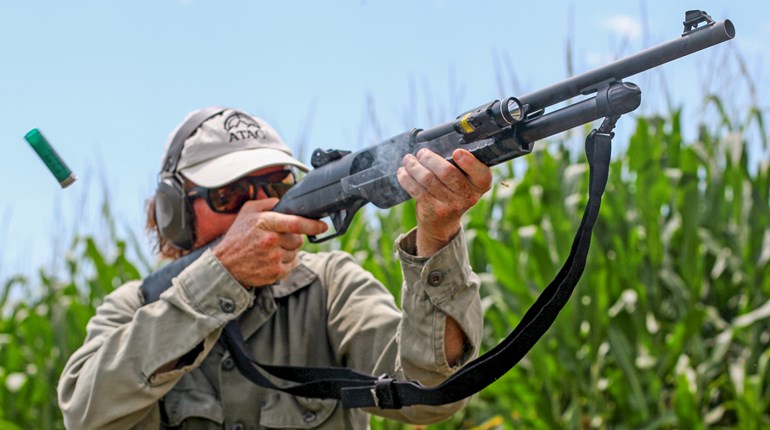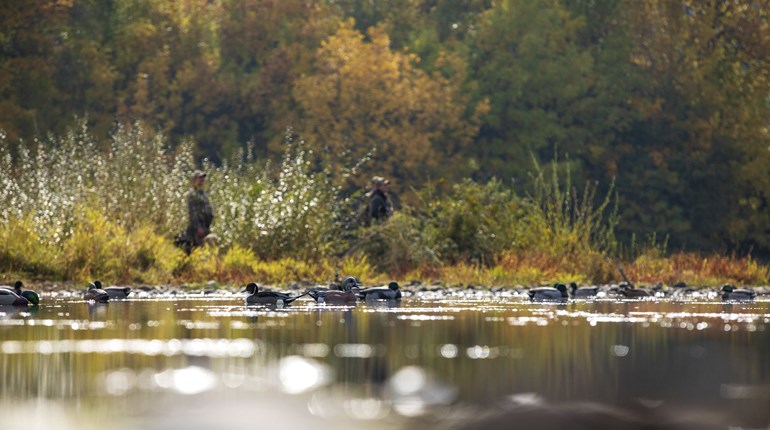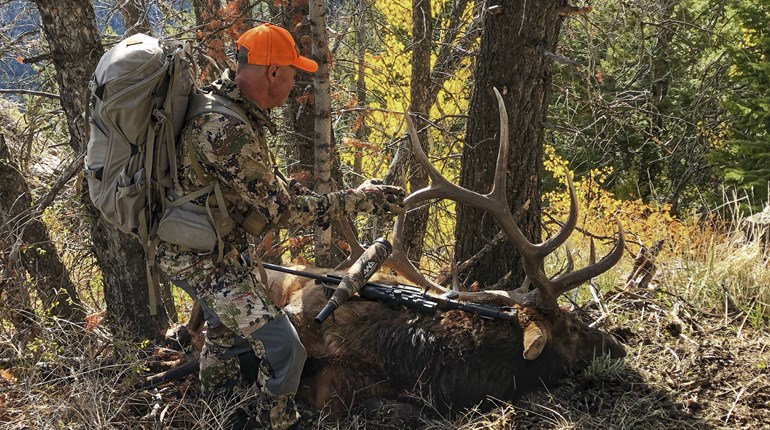
Today’s waterfowling may not be the best of times, but can’t be far from it. Our 2020 duck seasons and bag limits maintain the generous levels that have prevailed in recent years. By comparison to a low point some 30 years ago, season durations are one-third to one-half again longer and bag limits have doubled (with some exceptions) to an aggregate of six or seven ducks. Back then, America was phasing-in mandated use of steel shot, and the available shells were clearly inferior to the banned lead-shot product. Thankfully top ammunition manufacturers have since worked hard to develop innovative alternatives that perform even better than my favorite old lead No. 5's.
We should be grateful. Most of us can’t hunt full-time, but extend the calendar, and we’ll log more days. Did you know that goose hunting in North Dakota and Alberta starts up right about the time you’re receiving this magazine? Come Labor Day or thereabouts, numerous states open up for resident geese, which then sets the stage for special teal seasons during the last half of September. Skip forward a couple weeks and you hit most states’ initial regular-season split, an Indian-summer treat some call “wood duck season.”
Big ducks, you say? In fact, the cream of early-season hunting kicks off in late September/early October in the famed Prairie Pothole Region spanning the U.S.-Canada border, including parts of the Dakotas, Montana, Minnesota, Iowa, Alberta, Saskatchewan and Manitoba.
Last fall I made my first trip to that bucket-list destination, joining the Savage Arms marketing team for another “first,” i.e., a chance to try out their new Renegauge semi-automatic shotgun. It was a premiere unlike any I’ve seen from the firearm industry, both in transparency about the new gun’s development and Savage’s aspirations for it, plus the sheer number of media types assembled for the audition.

And our timing couldn’t have been better. An unusually cool September had pushed puddle ducks and giant Canadas south, birds that mostly had yet to encounter calling. Decamped at Stone Prairie Outfitters’ gracious lodge in Stutsman County, N.D., we were surrounded by acres of just-picked corn flanking countless ponds, and our guides’ scouting report was simply "birds everywhere.”
To brief guests on the Renegauge, Savage marketing chief Beth Shimanski introduced John Linscott, a young product engineer who resurrected a long-term shotgun project that had bogged down, and in short order set about reinventing its gas-operating system to work more efficiently. The result is called D.R.I.V., for the Dual Regulating Inline Valves that siphon the precise amount of propellant gas needed to work the action, then bleed off the rest.

What really stuck from John’s remarks were two key traits: 1) no matter the circumstances, it will cycle and keep on cycling without fail; 2) the gun’s felt recoil will be less than we’re accustomed to. Among other things, we also learned the Renegauge stocks mimic the adjustability of the company’s award-winning AccuStock for rifles. After the briefing, all hands lined up to shoot the new shotgun, breaking clays to our hearts’ content, keeping up the racket until dark.
■ ■ ■
In the morning we split up, some off to field setups, others to impoundments. I was assigned to Dalton’s group, and ended up gunning out of layout blinds with Beth and Savage co-workers Megan Harten and Jessica Treglia. All three women possessed some hunting experience, though likely not as much as the rest of us. And where we old hands were task-oriented, they were partying, carrying on like properly socialized duck and goose hunters are supposed to. We laughed with them, and learned more about the Renegauge and about a positive new energy at Savage. Lying flat as zombies in shoulder-to-shoulder coffins, we’d pop up to meet waves of incomers over the decoys. Shots drummed skyward and birds flared and fell, and then as they were retrieved, the hooting and the party reignited. Despite the awkward sit-up posture in the layouts, the Renegauge was shouldering and swinging with natural ease. Unlike standing in a pit or perched on a seat in a floating blind, the crunch position affords no way to brace oneself for the 12-gauge kick, yet even as we emptied numerous shell packs in the process of hammering our limits, no one seemed concerned about recoil.

The stock’s ability to custom-fit each user’s anatomy and shooting style makes a huge difference, particularly for small-statured folks, like some in our group. Interchangeable inserts make it easy to adjust length of pull and comb height, and further adjustments can be made to the buttpad’s vertical position and pitch (angle). A shotgun that truly fits eases target acquisition by aligning the shooter’s eye with the sighting rib, encourages proper cheek weld, and directs recoil laterally into the shoulder. Lessons learned via Savage’s influential AccuFit rifle stocks will now similarly benefit shotgunners.
■ ■ ■
Back for more, we returned to that same field the following morning, but moved our gauntlet next to a wire fence draped with tumbleweeds. Again, husky northern mallards strafed our rig and this time were joined by dozens of the region’s giant Canadas, huge and dark as gathering clouds until struck by the TSS pellets from our Federal Premium Black Cloud loads.
Maybe the ladies were a bit more subdued that second day, but not much as they cheered everyone on and asked Dalton questions he doesn’t normally hear. It struck me that this shotgun was helping make it easier for us to hit.

At just under 8 pounds, the Renegauge is no lightweight, but balances well and possesses lively shouldering and swing dynamics, and I’m not alone in thinking so. In the months after my hunt, two fellow NRA Publications editors, both relatively new to shotgunning, got to take a crack at sporting clays with the Renegauge, while another from the opposite end of the experience spectrum hunted sea ducks from small boats rolling in heavy surf. All agreed the handling was smooth and intuitive, that hits came readily and exceeded their expectations, no doubt aided by the surprising lack of recoil. In fact some of our editors came away convinced it was the softest-shooting 12-gauge they’d ever fired.
■ ■ ■
For our final field setup, we combined groups and formed a 12-man picket line of layout blinds amid a sea of wheat stubble. It was the biggest en bloc waterfowling party ever for me, and though there were more than enough birds in the vicinity, I wondered if they’d give us a chance.
The greenheads came in typical fashion, with gangs of three to five breaking off from bigger flocks to circle, cup up and finally dangle orange feet. No problem there, and remarkably, right, left and center of the line all got roughly equal shooting.

It was different with the geese. At first they were slow to acknowledge and when they eventually did, flared prematurely. But as the sun rose their numbers did too, and while ducks grew scarce, the honkers rallied to us. They came in bunches and gunfire rattled the stubble. Twelve-pounders were falling one after another, including a classic kamikaze that nearly took out a guide. Our faster shooters had to reload hurriedly as the big birds piled in, but then in a flash we got the command to STOP shooting. We were limited out. What a frenzy! For a couple beats there was silence, then from the opposite end I could hear Beth, Megan and Jessica chattering.
For that kind of high-intensity shooting, hunters want a gun that cycles at lightning speed. They’re all fast, in my opinion, but note Savage says its semi-auto runs as fast as any. Equally important are manual ergonomics and sure-handed operation. The Renegauge’s bolt handle and release are plenty big enough without being oversized, and the loading gate ushers in fresh shells without a hitch. Notable, too, is a trigger that factory-set at 3½ pounds, more like one of Savage’s trend-setting rifle AccuTriggers than those we’re accustomed to on field shotguns.
■ ■ ■
Late afternoon we crouched in cattails lining a windy pothole, and though divers and unwanted cormorants streamed past, they avoided our natural blind. Strings of teal landed out of range, then ignored calling and other efforts to get them airborne.
Eventually we knocked down a couple ducks on passing shots, but it soon became clear this setup would not match the others. Beth and the ladies nonetheless found the whole thing quite comical, especially when one partner uttered an off-color epithet at an uncooperative swimmer. He got a lot of deserved razzing for that. Yet as hunting karma would have it, he (actually he was me) got lucky on the day’s last chance and snagged a blue-winged teal zipping perhaps a yard over the water with the wind at its back. As ofttimes happens, the situation made the shot: see it, pivot and let fly. The Savage fit and felt great, and its red fiber-optic front bead on a steel ventilated rib forms a slick sighting platform.

While the late-day wind had a mild bite, the weather for our hunt was perfect. Too perfect, in fact, to gauge performance in the wet, cold, nasty stuff where such guns really earn their stripes. The developers were fully cognizant of those demands and so for durability’s sake the internal, reciprocating components are chrome-plated, and the barrel is coated in melonite. The Renegauge’s one-piece action-bar assembly simplifies takedown and cleaning, and because the TIG-welded assembly is self-contained and held to exacting tolerances for straightness, we can’t foresee long-term maintenance issues. It’s worth noting that after taking the Renegauge out for eiders in saltwater off the Maine coast, American Rifleman Associate Editor Christopher Olsen observed no overnight rusting on external or internal surfaces, and the gun kept running trouble-free.
■ ■ ■
I left North Dakota with a haul of duck and goose meat, hoping it wouldn't be my last ride with the Renegauge. I had to be patient, but that chance came during turkey season, and I can report the Renegauge easily transitioned from agile wingshooter to formidable pattern-blaster.
For 2020, three basic models are in the line, all 12-gauge, 3-inch guns, and for now, synthetic stocks only. There's a plain-stocked Field Grade available with a 26- or 28-inch barrel; a Waterfowl model with the same barrel options plus Mossy Oak Shadow Grass Blades camo treatment; and a Turkey model with a 24-inch barrel, also with a camo finish in Mossy Oak Obsession or Bottomland patterns. MSRPs were initially set at $1,449 to $1,549, but not surprisingly, there are deals to be had in the marketplace.
Given its engineering, pricing and the Renegauge’s high-profile rollout, Savage is serving notice it expects to compete at the top of the market. “We needed [our shotgun] to be something unique, something special,” says Savage CEO Al Kasper. “It’s never been our style to come out with me-too stuff. We didn’t do all this just to build ‘a good gun for the money.’ No, in all areas, we’re determined to build the best guns, period. And this is one of them.”

Savage Renegauge Technical Specifications
• Action type: gas-operated, semi-automatic shotgun
• Gauge: 12; 3" chamber
• Magazine: four-round capacity (ships with two-round plug)
• Sights: ventilated rib with single red fiber-optic bead
• Trigger: single-stage, 3 lbs., 8 oz. pull
• Weight: 8 lbs.
• Overall Length: 49.5"
• Barrel: 28", fluted
• Stock: synthetic, black or Mossy Oak camo, adjustable for length of pull, comb height, buttpad position and pitch
• LOP: 14.25"-15.07"
• DAC: 1.30”
• DAH: 1.95”
• Accessories: fitted locking hard case, trigger lock, choke tubes (imp. cyl., mod. and full) and wrench, stock shims and extra cheekpiece
• MSRP: $1,449-$1,549; savagearms.com
Prairie Waterfowl Come to Roost
Hunting prairie pothole country certainly scratched a long-time itch, but it took a later conversation with Dr. Frank Rowher, president/chief scientist of Delta Waterfowl, to help me understand why what happens there matters to nearly all U.S. duck and goose hunters.

For starters, it is the continent’s most prolific nesting ground. “Though it’s a relatively small total area, the number of birds produced is an outlandish proportion,” said Rowher. “Anywhere from 50 to 70 percent … talking about the ducks we routinely harvest. And so it’s vital for productivity. It’s a big fraction on geese, too, though not as large when you consider all the species we love to hunt. However giant Canadas have dramatically increased. I can remember starting to work in North Dakota in the ‘90s, and a goose nest was rare. Now they are a dime a dozen.”
The good news is that the region’s productivity is increasing. “The big driver is water and when we have wet years it goes up,” said Rowher. “We produced ducks like crazy in the Dakotas this year because we have so much water. They had a very good early spring.”

I also learned you don’t actually have to go there to hunt prairie waterfowl. “A pile of birds funnel through the region and spread out in big numbers to all four flyways, particularly hunters’ preferred species,” added Rowher. “We have pintails migrating to California, the Gulf Coast and the Carolinas. Parkland canvasbacks, known for wintering in Chesapeake Bay, are abundant in Louisiana and San Francisco Bay. Interestingly, western mallards go to the southern Atlantic. Prairie ducks go everywhere.”
As good as the overall picture is at present, things can change fast. Simply put, when potholes are filled, ducks and geese thrive, including birds that eventually migrate to where many of us hunt. Weather naturally is a huge factor, but conservation-minded leadership also makes a difference. “Delta does a lot to protect the habitat,” said Rowher. “We’re not going to buy land because we don’t have that kind of budget and it’s not effective. We promote policies that keep potholes from being drained. That’s the worst thing for waterfowl. We expect a drought every few years, but when a drain goes in, it’s no longer a pond. That’s the worst thing for ducks. We strive to make working wetlands a part of federal farm bills so there are payments for farmers, so they have less incentive to drain ponds and potholes and convert them to agriculture.”
Between now and mid-October, duck and goose seasons are set to open in all four flyways, encompassing all but a few U.S. states. While space won’t allow a comprehensive listing, here’s a summary of a wealth of opportunity nationwide. Keep in mind that actual season dates, bag limits and other regulations are controlled by the individual states, so it’s necessary to go to them for particulars. A listing of all 50 states’ wildlife management agencies can be found at AmericanHunter.org/state-fish-and-game-info.

Geese—Between “management take” in a few northern states and managing America’s robust resident Canada goose populations, September honker hunts are now the norm from coast to coast. Many year-rounders live where suburbia meets countryside, and consequently outfitters have set up shop in metro areas. Such nuisance control has brought some odd wrinkles to our culture, like golf course and parking-lot drainage-pond hunts joining traditional haunts like ag fields, rivers and marshy spots between developed properties. Warm-weather hunters can be seen emerging from blinds or heavy vegetation dressed in T-shirts, shorts and sneakers. Resident seasons typically come with generous bag limits, but success also means having to act fast to get one’s kill on ice.





































